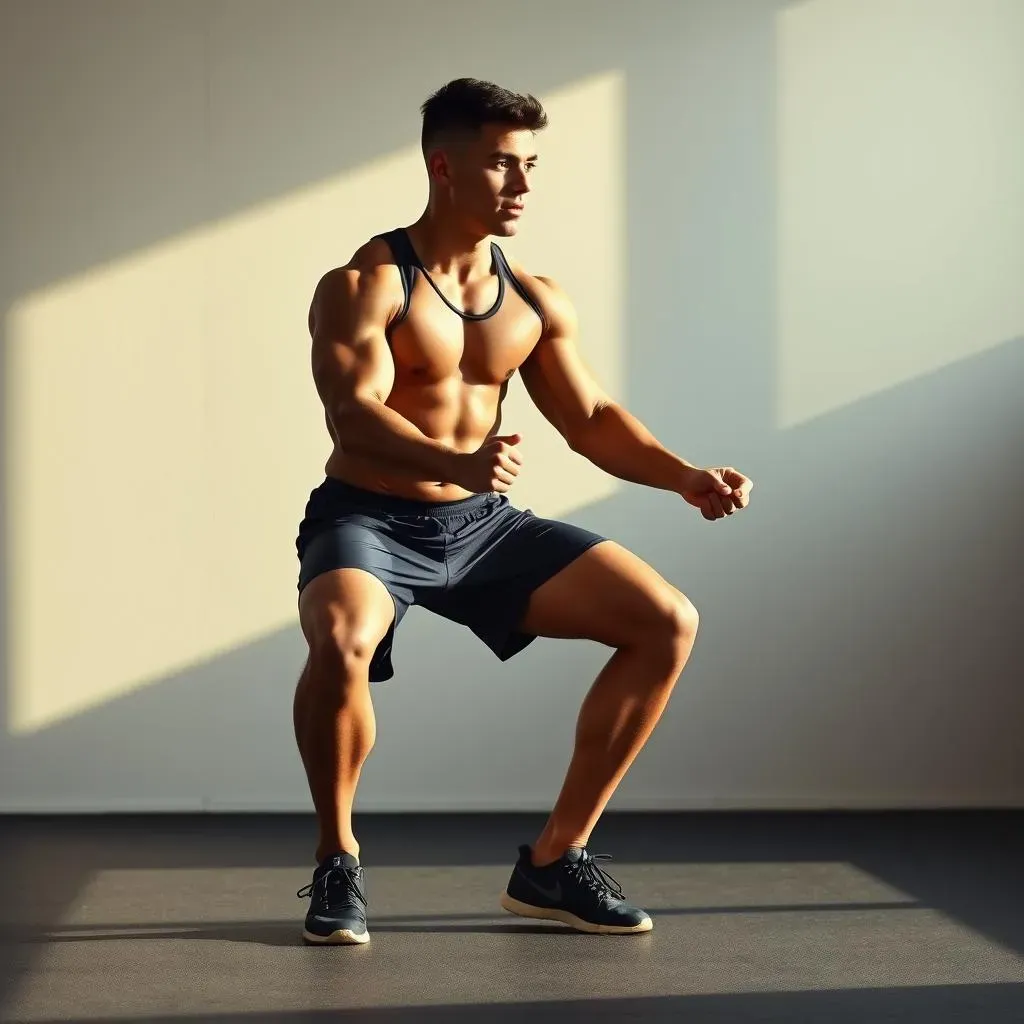Table of Contents
Ready to transform your legs without stepping foot in a gym? You’ve come to the right place. This isn't your average "squats and lunges" routine. We're diving deep into the world of advanced leg workouts at home, where we'll explore challenging bodyweight exercises and how to effectively use equipment to build serious strength and muscle. Forget those endless hours on the treadmill. We’re about to show you how to create a leg day that's both effective and convenient. We'll break down the best exercises, teach you how to intensify your workouts, and provide the knowledge you need to design a program that’ll leave your legs feeling like they’ve conquered a mountain. Get ready to push your limits and unlock the full potential of your lower body, all from the comfort of your own home. Let's get started, shall we?
Advanced Bodyweight Leg Exercises at Home

Advanced Bodyweight Leg Exercises at Home
Okay, so you've mastered the basics? Good. Now, let's ditch the kiddie pool and jump into the deep end of bodyweight leg training. We're talking exercises that'll make your legs tremble in the best way possible. Forget just squats and lunges; we are going to push the boundaries. Think pistol squats – those single-leg balance tests that make you feel like you're defying gravity. Then we'll explore shrimp squats, where you gracefully (or not so gracefully at first) lower yourself down while holding one leg behind you. These aren't just about looking cool; they build serious strength, balance, and control. We're not just going to do these exercises mindlessly, we're going to learn the proper form and how to scale them up to make them more challenging, so that you can continue to grow.
And it's not all about single-leg madness, though that's a big part of it. We'll also get into plyometrics, explosive movements like jump squats, and lunge variations. Ever tried a Bulgarian split squat with a jump at the top? No? Well, get ready. These exercises will not only challenge your strength, but also your cardiovascular endurance, turning your leg workout into a full-body experience. The key here is control and intention. Each rep should be deliberate, focusing on engaging the right muscles and maintaining proper form. It is not just about the number of reps, but the quality of each movement.
Exercise | Description | Why it's Advanced |
|---|---|---|
Pistol Squat | Single-leg squat, other leg extended forward | Demands balance, strength, and flexibility |
Shrimp Squat | Single-leg squat, one leg held behind you | Requires balance, quad and glute strength |
Bulgarian Split Squat Jump | Split squat with a jump at the top of the movement | Explosive power, balance, coordination |
Plyometric Lunges | Alternating lunges with a jump between each rep | Cardio and strength, power and coordination |
Elevating Your Leg Day: EquipmentBased Home Workouts

Elevating Your Leg Day: EquipmentBased Home Workouts
Dumbbells: Your Versatile Leg Day Allies
Alright, so bodyweight is great, but sometimes you need a little extra oomph, right? That's where dumbbells come in. They're not just for your arms, folks! For legs, they’re like adding a turbocharger to your favorite car. Think about it: weighted squats, lunges, and Romanian deadlifts (RDLs). These aren't your grandma's leg exercises. Holding dumbbells forces your muscles to work harder to stabilize the weight, leading to better muscle activation and strength gains. We're not talking about using tiny weights either, choose a weight that challenges you, something that makes you feel like you're actually working. It’s about finding that sweet spot where you can maintain proper form but also feel the burn. And don't forget variations! Goblet squats, front squats, and even walking lunges with dumbbells can take your leg workout to a whole new level.
Also, let's talk about progressive overload. It's not just about doing more reps; it's about gradually increasing the weight you're lifting. With dumbbells, this is easy to track and implement. As you get stronger, grab heavier dumbbells. This will ensure your muscles are constantly challenged and adapting. If you don't have a full set of dumbbells, you can get creative. Use resistance bands to add extra resistance to your exercises or fill up water bottles for a cheap alternative. The key is to find what works best for you and to keep pushing yourself. Remember, the goal is to make your legs feel like they've just completed a marathon, in a good way.
Resistance Bands: The Secret Weapon for Home Leg Gains
Don't underestimate the power of resistance bands, they are not just for beginners or for rehabilitation. These stretchy wonders can add a new dimension to your leg workouts. Think about it: banded squats, lateral walks, and glute bridges with a band around your thighs. These exercises target the muscles in a different way than dumbbells, focusing on constant tension throughout the movement. Plus, resistance bands are super portable and affordable, making them a great option for anyone who wants to workout at home. They also add a different type of challenge, it's not just about the weight, it's about controlling the resistance and maintaining proper form. These help in strengthening stabilizer muscles and improving overall balance and coordination.
Also, resistance bands are great for adding extra intensity to your bodyweight exercises. Wrap a band around your thighs during squats or lunges to make them even more challenging. Use them to assist with exercises like pistol squats or shrimp squats, allowing you to perform more reps with better form. The possibilities are endless. They’re also helpful for warm-ups, activating your muscles before the main workout. The key is to experiment with different band tensions and exercises to find what works best for you. Remember to focus on the quality of each rep and not just the quantity. Your legs should feel the burn from the first rep to the last.
Equipment | Exercises | Benefits |
|---|---|---|
Dumbbells | Weighted squats, lunges, RDLs | Strength, stability, progressive overload |
Resistance Bands | Banded squats, lateral walks, glute bridges | Tension, portability, muscle activation |
Designing Your Advanced Leg Workout at Home

Designing Your Advanced Leg Workout at Home
Structuring Your Week for Leg Domination
Okay, so you've got the exercises down, but how do you put them together into a workout plan? It's not just about throwing a bunch of exercises together and hoping for the best. Effective training requires a structured approach. Think of your training week like a well-written novel, each chapter building upon the last. You wouldn’t just start reading a book from a random page, would you? Same goes for your workouts. Start with a solid warm-up, 5-10 minutes of light cardio, and dynamic stretching to get your muscles ready to work. Then, structure your workout into focused segments. You could dedicate one day to lower body strength, focusing on heavy compound movements like squats and deadlifts, and another to plyometrics, focusing on explosive power. Don't forget a rest day, your muscles grow when you rest, not when you are in the gym.
Also, when it comes to reps and sets, it's all about your goals. If you want to build strength, focus on lower reps (6-8) with heavier weights. If you want to build muscle, go for moderate reps (8-12). And for endurance, higher reps (12-15) with lighter weights. Remember, it’s better to do fewer reps with perfect form than many reps with sloppy form. Listen to your body. Don’t push through pain. If something doesn't feel right, stop and adjust. Consistency is the key. Stick to your plan, but don't be afraid to adjust it as you progress. Your body will adapt to the training, so you will need to increase the challenge by increasing the weight, reps, or sets.
Progressive Overload: The Secret Sauce to Leg Growth
Progressive overload is a fancy term for "getting stronger over time." It's the most important concept you need to understand when designing your leg workouts. It means that you need to gradually increase the stress you place on your muscles over time, to force them to adapt and grow. Think of it like climbing a staircase, each step is a little bit higher than the last. You wouldn’t expect to climb to the top of the stairs in one go, would you? It's the same with your workouts. You can increase the load by adding more weight, doing more reps, doing more sets, or making the exercises harder. It doesn’t have to be all at once. Even small increases over time will add up to big results.
Also, don't be afraid to experiment. Try different exercises, different rep ranges, and different rest periods. The most important thing is that you are constantly challenging yourself and that you are making progress. It's not just about lifting heavier weights; it's about making your workouts more challenging in different ways. You could try decreasing the rest time between sets, or you could try doing more challenging variations of the exercises. The key is to listen to your body and to find what works best for you. Remember, the goal is not just to complete the workout, but to constantly challenge yourself so that you are always improving.
Training Principle | Description | How to Implement |
|---|---|---|
Progressive Overload | Gradually increasing the stress on your muscles | Increase weight, reps, sets, or difficulty |
Specificity | Training for specific goals | Choose exercises that match your goals |
Rest and Recovery | Allowing your body time to repair and grow | Plan rest days, get enough sleep, eat well |
Listening to Your Body: The Most Important Rule
All this talk about pushing your limits is great, but it's crucial to listen to what your body is telling you. It's not about ignoring pain, but about understanding the difference between muscle fatigue and injury. Think of your body like a well-tuned engine; if you keep pushing it too hard without giving it a rest, it's going to break down. So, don't be afraid to take rest days when you need them. Don't feel guilty if you can't do all the reps or lift all the weight that you planned to. It's better to take a step back than to get injured and have to stop completely.
Also, pay attention to your form. If your form starts to break down, it's a sign that you're pushing too hard, and you need to take a break or reduce the weight. Remember, it's not about how much you can lift, but how well you can lift it. Consistency is key. It is better to do less and do it properly, than to do more and risk injury. Proper form will allow you to train longer and more effectively. Don't compare yourself to other people, everyone is different and everyone progresses at a different pace. Focus on your own journey. It's a marathon, not a sprint.
